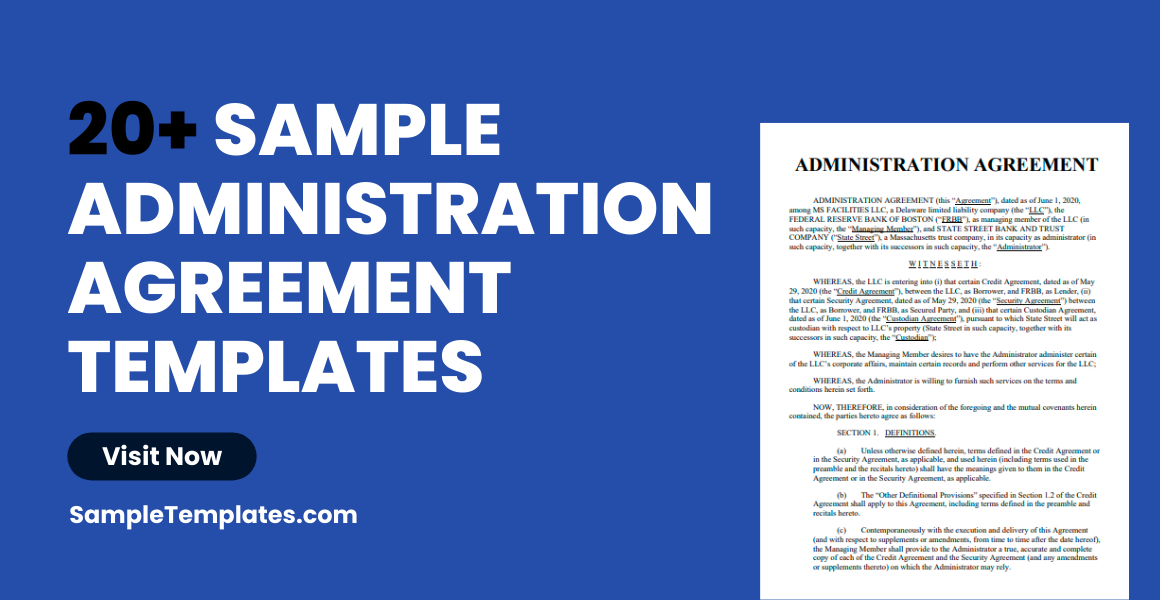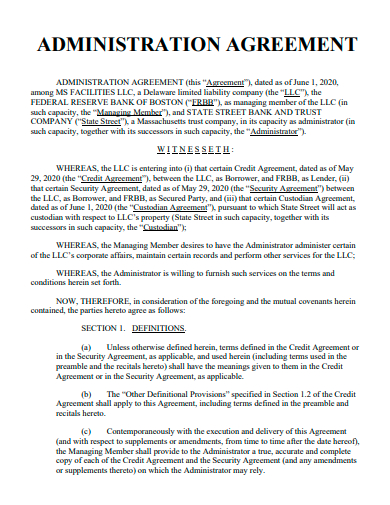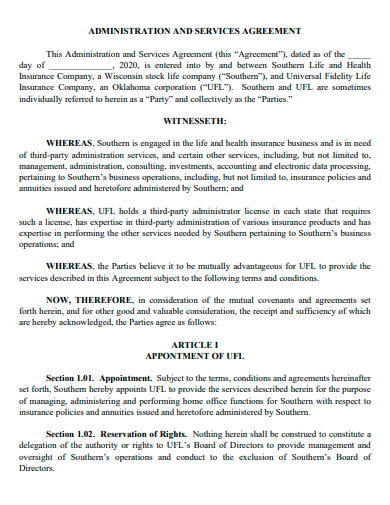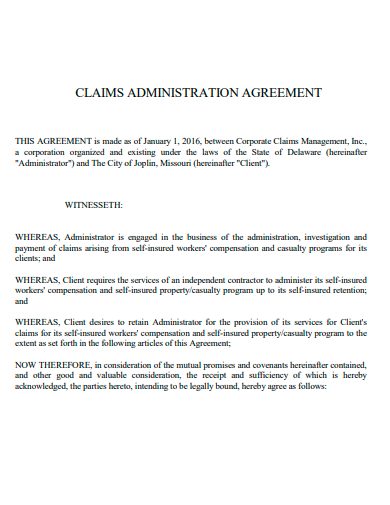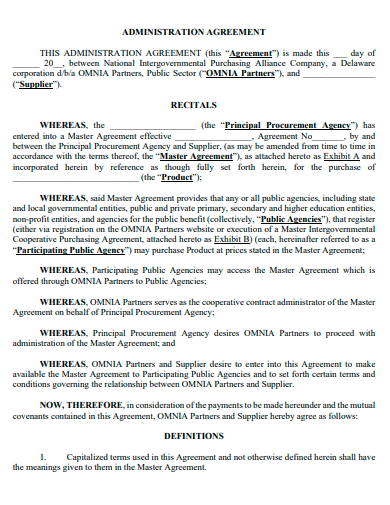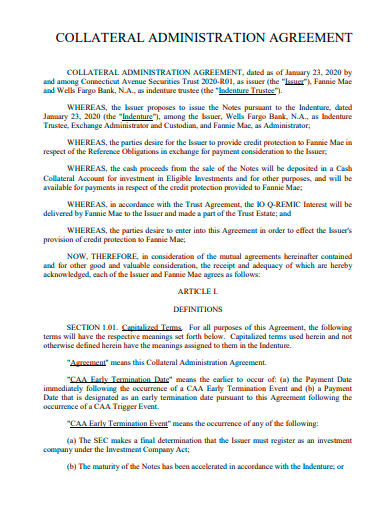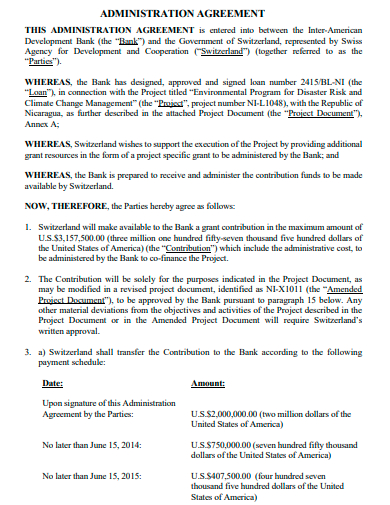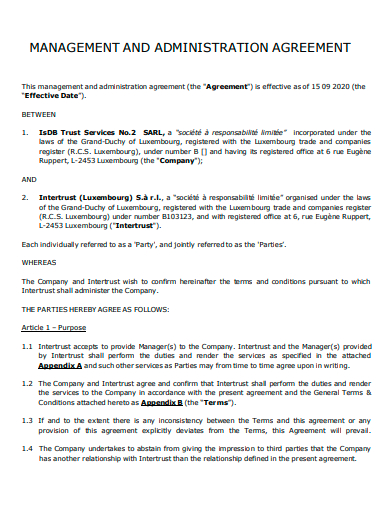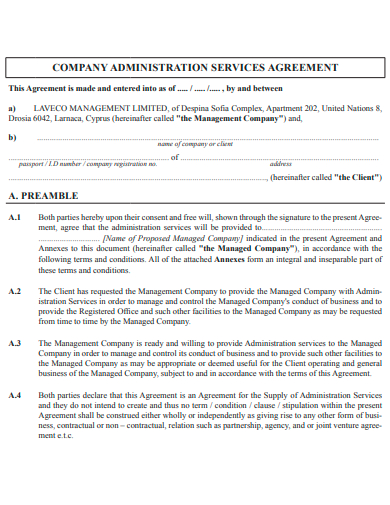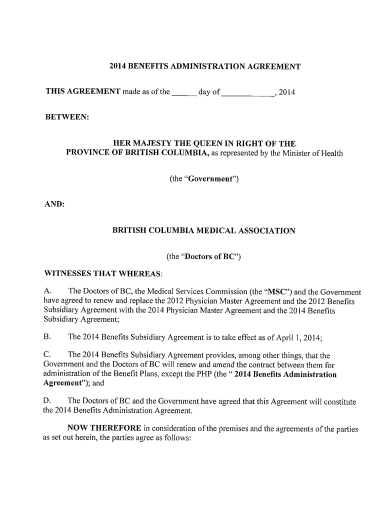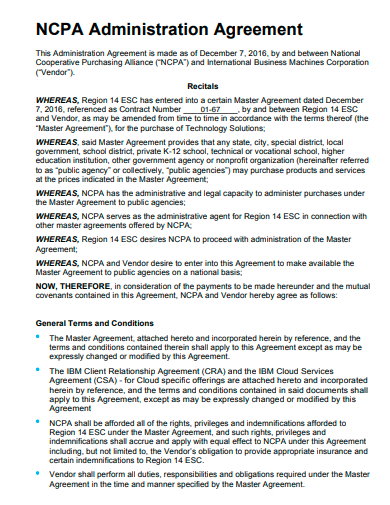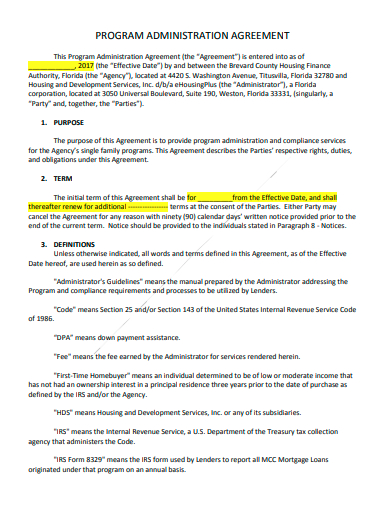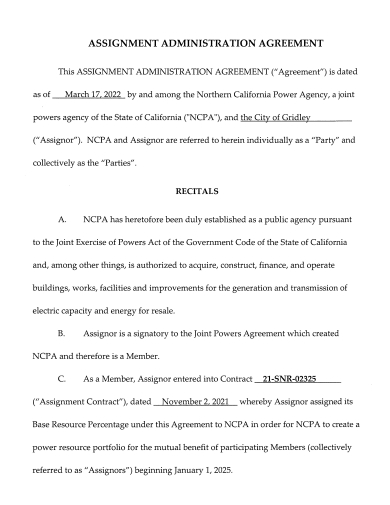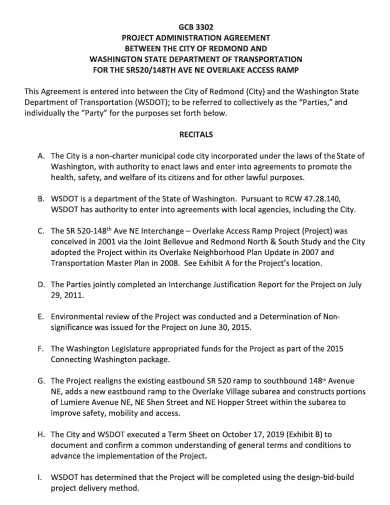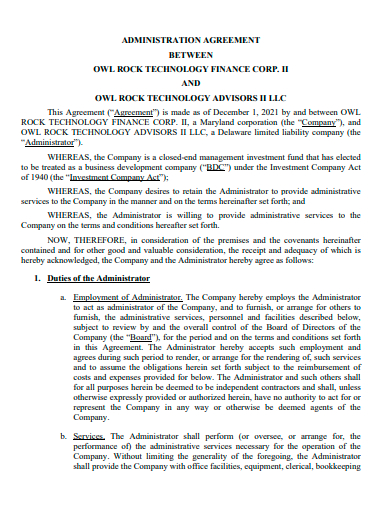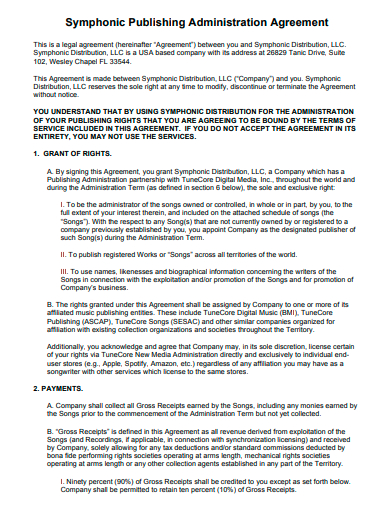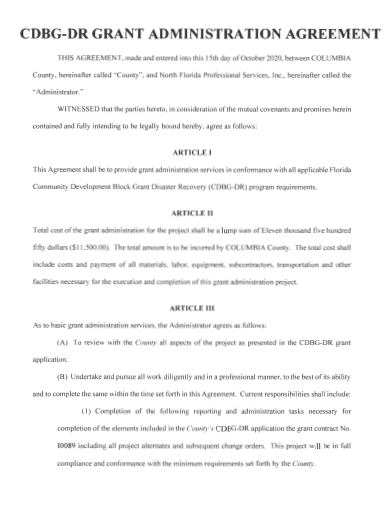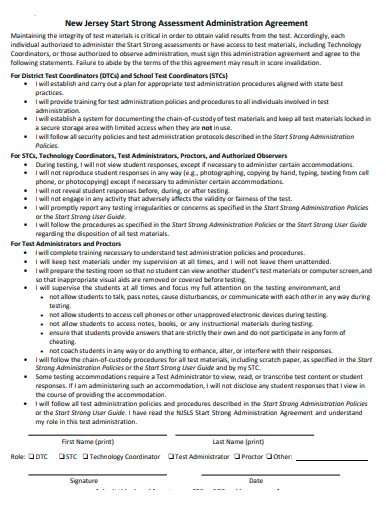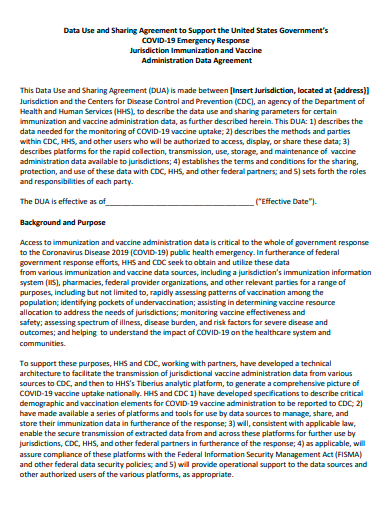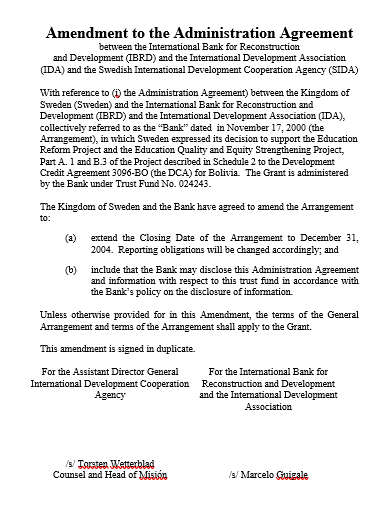In the intricate landscape of business agreements, having the right resources is paramount. Our Sample Administration Agreement Template provides an unparalleled foundation for administrative partnerships. Catering to both newcomers and veterans in the business world, this template ensures a clear, comprehensive framework for every deal. By weaving in industry best practices and transparent guidelines, it paves the way for a seamless and efficient business agreement journey. Step in and harness the power of a well-structured administrative agreement.
20+ Administration Agreement Samples
1. Administration Agreement Template
2. Administration and Services Agreement Template
3. Claims Administration Agreement Template
4. Sample Administration Agreement Template
5. Collateral Administration Agreement Template
What is an Administration Agreement?
An Administration Agreement is a formal document that delineates the roles, responsibilities, and obligations of a party, typically known as the administrator, entrusted with managing specific tasks or duties on behalf of another party. This type of agreement is commonly used in various sectors, from finance and real estate to entertainment and technology. It outlines the scope of services the administrator is to provide, the compensation they are to receive, and other pertinent terms and conditions.
Key Components of an Administration Agreement:
Parties Involved: This section specifies the details of both the administrator and the party or parties seeking the administrative services. It generally includes their names, addresses, and other identifying information.
Scope of Services: A crucial element of the agreement, this segment clearly lists the services the administrator is expected to perform. It can be as broad as overseeing an entire project or as specific as managing a single aspect of a business.
Compensation: This part of the agreement details how the administrator will be compensated for their services. It could be a fixed fee, a percentage of profits, hourly rates, or any other agreed-upon structure.
Duration: Here, the start and end dates of the agreement are outlined. It could be for a specific period or until the completion of a particular project.
Termination: This section addresses the conditions under which the agreement can be terminated. It usually includes provisions for both parties, allowing for termination under specific circumstances.
Confidentiality: Given the administrator might have access to sensitive information, many agreements include a confidentiality clause. This clause prohibits the administrator from disclosing or using any confidential information they come across during their tenure.
Liabilities and Indemnities: This segment outlines the liability of the administrator and often includes indemnity clauses, which protect either party from potential losses or damages arising from breaches of the agreement or negligence.
Dispute Resolution: This provision sets out the methods by which any disputes between the parties will be resolved. Common methods include arbitration or mediation.
Miscellaneous Provisions: This section can cover a range of topics, including governing law (which jurisdiction’s laws will apply to the agreement), assignment (whether the administrator can assign their duties to another party), and amendments (how the agreement can be changed).
Importance of an Administration Agreement:
Having a well-drafted Administration Agreement in place is essential for several reasons:
Clarity and Transparency: Such an agreement clearly sets out the expectations for both parties, reducing the risk of misunderstandings or conflicts later on.
Protection: It provides legal protection to both parties. If one party fails to uphold their end of the agreement, the other can refer to the document when seeking remedies.
Professionalism: Having a formal agreement in place underscores a sense of professionalism and can instill confidence in third parties, such as investors or partners.
In conclusion, an Administration Agreement is a comprehensive tool that ensures a smooth and efficient collaboration between an administrator and those requiring their services. By specifying roles, responsibilities, and compensation, among other aspects, it provides a roadmap for a successful partnership, safeguarding the interests of all involved parties.
6. Basic Administration Agreement Template
7. Management and Administration Agreement Template
8. Company Administration Services Agreement Template
9. Benefits Administration Agreement Template
10. Second Amendment to Administration Agreement Template
11. Administration Agreement Example
12. Program Administration Agreement Template
How Effective Is Your Administration Agreement?
An Administration Agreement serves as the backbone of many professional relationships, ensuring clarity, setting expectations, and reducing potential disputes. But merely having an agreement isn’t enough; its effectiveness can make the difference between a successful partnership and a fraught one. Here’s how to assess the effectiveness of your Administration Agreement:
Comprehensiveness: A robust agreement should be exhaustive in its coverage. If it leaves out essential details, it could lead to ambiguity, which can later become a point of contention. An effective agreement doesn’t just list tasks—it describes them in detail, ensuring both parties have a clear understanding of their roles and responsibilities.
Clarity: An effective Administration Agreement avoids jargon and complex language. It’s written in a way that’s accessible to all parties, regardless of their background. Each clause should be precise, leaving no room for varied interpretations.
Flexibility: Business dynamics can change. An effective agreement has provisions that allow for alterations or adjustments, provided they are mutually agreed upon. This ensures that the agreement remains relevant and practical over time.
Enforceability: Provisions within the agreement should be enforceable. If the agreement contains clauses that are legally untenable, it might render the entire document void. An effective agreement adheres to the legal standards of the jurisdiction it operates in.
Dispute Resolution: Differences in understanding and execution can arise even with the most detailed agreements. An effective Administration Agreement outlines clear mechanisms for dispute resolution, be it through arbitration, mediation, or legal action.
Review and Renewal Provisions: The business environment is ever-evolving. Provisions for periodic reviews ensure that the agreement remains in sync with changing requirements. Renewal clauses, which detail the conditions and timelines for agreement extension, can save both parties significant time and effort down the road.
Protection Against Liabilities: An effective agreement clearly states the liabilities of each party, detailing the repercussions of breaches or non-compliance. It also incorporates indemnification clauses, protecting parties from potential unforeseen damages.
Termination Clauses: Sometimes, despite best efforts, professional relationships need to end. A forward-thinking Administration Agreement will clearly outline the grounds for termination, notice periods, and any associated penalties or processes.
Feedback Mechanism: The best agreements incorporate avenues for feedback. This allows parties to communicate their satisfaction levels, concerns, or suggestions, fostering a culture of continuous improvement.
Confidentiality and Non-compete Clauses: An effective agreement should protect sensitive information, ensuring that neither party misuses proprietary data. Non-compete clauses can also be vital, especially if the administrator deals with multiple clients in similar sectors.
Assessing the effectiveness of your Administration Agreement is not just a one-time task. Regular reviews and updates, coupled with open communication between parties, can ensure that it remains a living document, evolving with the needs of the relationship. A well-crafted, effective agreement not only safeguards interests but also fosters trust, laying the foundation for a fruitful and lasting partnership.
13. Assignment Administration Agreement Template
14. Project Administration Agreement Template
15. Printable Administration Agreement Template
16. Publishing Administration Agreement Template
17. Summer Session Administration Agreement Template
18. Grant Administration Agreement Template
19. Assessment Administration Agreement Template
20. Administration Data Agreement Template
21. Amendment to Administration Agreement Template
Tips in Creating an Administration Agreement
Before drafting, have a clear understanding of the primary purpose of the agreement. Are you looking to delegate specific administrative tasks, or are you aiming for a more comprehensive oversight? This foundational understanding will guide the entire drafting process.
Define Roles Clearly
Every party involved in the agreement should have their roles and responsibilities meticulously defined. Ambiguity can lead to conflicts down the line, so it’s essential to spell out who is responsible for what. This clarity ensures that all tasks are accounted for and helps in accountability.
Use Plain Language
While legal documents often lean towards complex jargon, strive for clarity and simplicity. Use plain language as much as possible. This not only makes the agreement more accessible but also reduces the potential for misunderstandings.
Incorporate Flexibility
The business world is dynamic. As such, your agreement should have provisions that allow for changes under mutually agreed-upon circumstances. Whether it’s adjusting to new regulations or adapting to business growth, flexibility can ensure the agreement remains relevant.
Ensure Legal Compliance
Always ensure that your agreement is compliant with local laws and regulations. This might require consultation with legal experts familiar with your industry. An agreement that doesn’t adhere to legal standards can become null and void, rendering it useless.
Address Confidentiality Concerns
Given that administrators often handle sensitive information, it’s vital to include confidentiality clauses. These clauses should specify what constitutes confidential information and the repercussions for any breaches.
Set Clear Compensation Terms
Whether it’s a flat fee, hourly rate, or another compensation structure, the terms should be transparent. Define the payment timelines, methods, and any conditions tied to compensation, like performance metrics or milestones.
Plan for Dispute Resolution
Conflicts can arise, even with a well-drafted agreement. Instead of leaving disputes to chance, include a clear mechanism for resolution. This could be through mediation, arbitration, or legal avenues.
Include Termination Provisions
Every agreement should have a defined beginning and end. Detail the conditions under which the agreement can be terminated by either party, the notice required, and any associated implications or penalties.
Regularly Review and Update
An Administration Agreement is not a static document. Business needs, industry standards, and regulations can change. As such, include provisions for regular reviews and updates to ensure the agreement stays current.
Seek External Feedback
Before finalizing, consider getting feedback from a third party, preferably someone familiar with administration agreements or your industry. They might offer insights or spot oversights you may have missed.
Concluding Thoughts
Crafting an Administration Agreement requires a mix of foresight, precision, and adaptability. By keeping the above tips in mind, you can ensure that your agreement not only serves its immediate purpose but also stands the test of time, fostering a mutually beneficial and harmonious business relationship.
Related Posts
FREE 10+ Mentoring Agreement Samples In MS Word | Apple Pages | PDF
FREE 10+ Partner Agreement Samples In MS Word | Google Docs | Apple Pages | PDF
FREE 10+ Individual Agreement Samples In MS Word | Google Docs | Apple Pages | PDF
FREE 10+ Strategic Agreement Samples In MS Word | Google Docs | Apple Pages | PDF
FREE 10+ Equity Agreement Samples In MS Word | Google Docs | Apple Pages | PDF
FREE 10+ Producer Agreement Samples in MS Word | Apple Pages | PDF
FREE 10+ Grant Agreement Samples In MS Word | Apple Pages | PDF
FREE 8+ Meeting Agreement Samples in MS Word | Google Docs | Apple Pages | PDF
FREE 10+ Community Agreement Samples In MS Word | Google Docs | PDF
FREE 8+ Real Estate Option Agreement Samples in MS Word | PDF
FREE 10+ Call Option Agreement Samples In MS Word | PDF
FREE 10+ Advertising Agreement Samples In MS Word | Google Docs | Apple Pages | PDF
FREE 10+ Car Agreement Samples In MS Word | Google Docs | Apple Pages | PDF
FREE 10+ Horse Agreement Samples In MS Word | Apple Pages | PDF
FREE 10+ Option Agreement Samples In MS Word | Google Docs | Apple Pages | PDF
